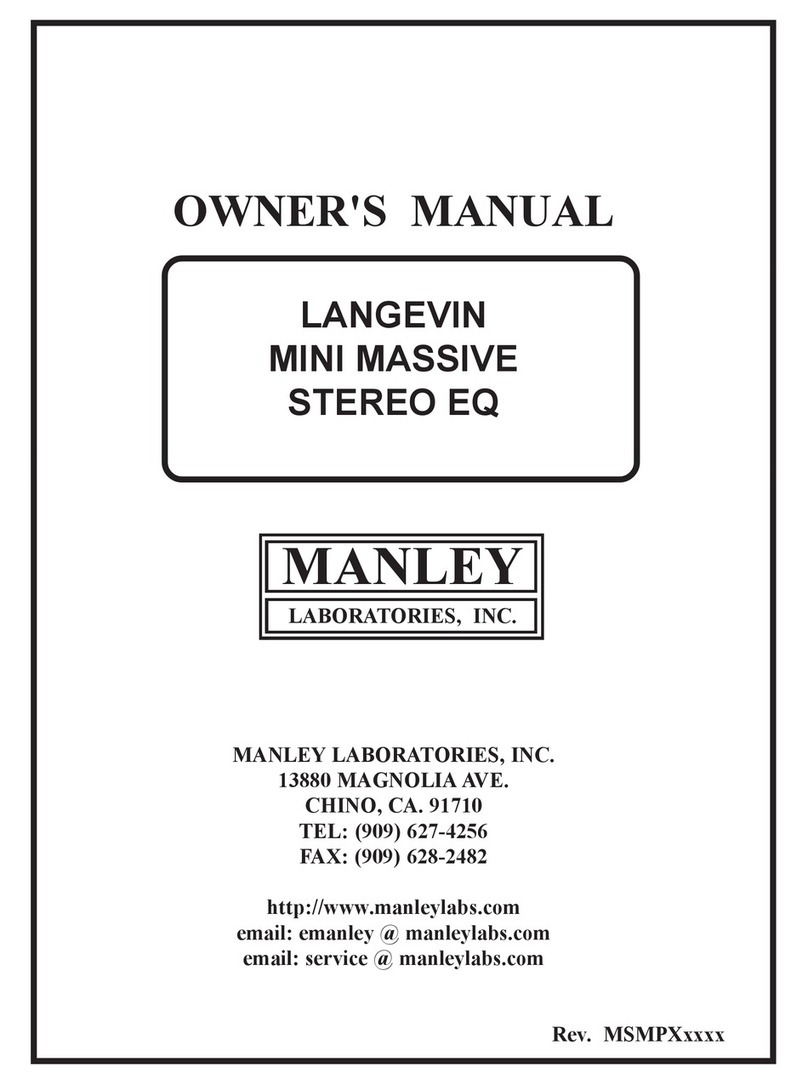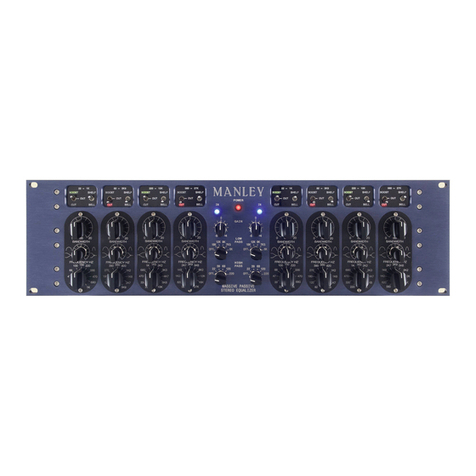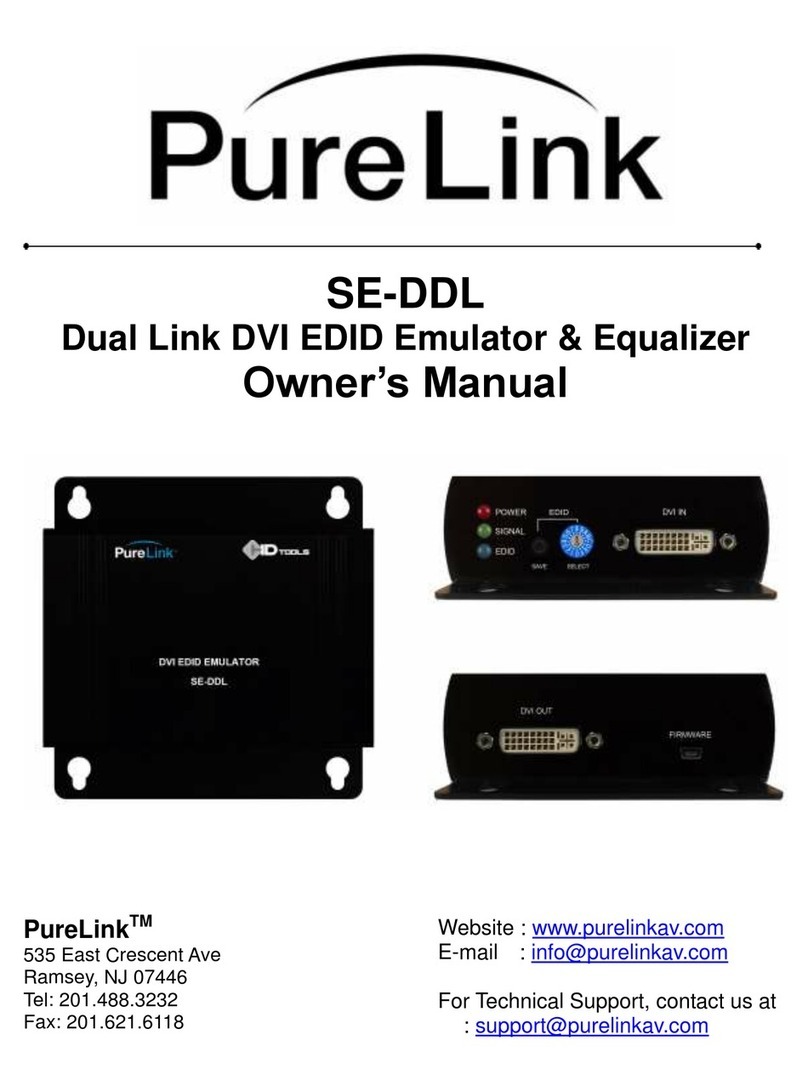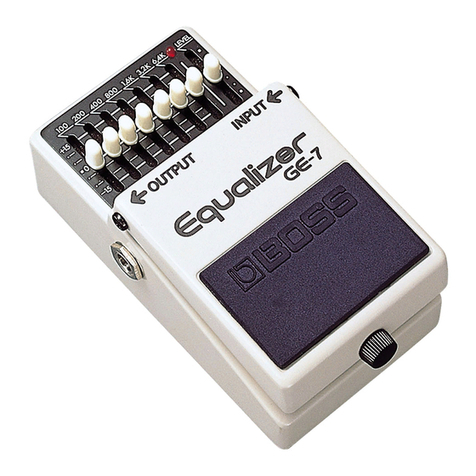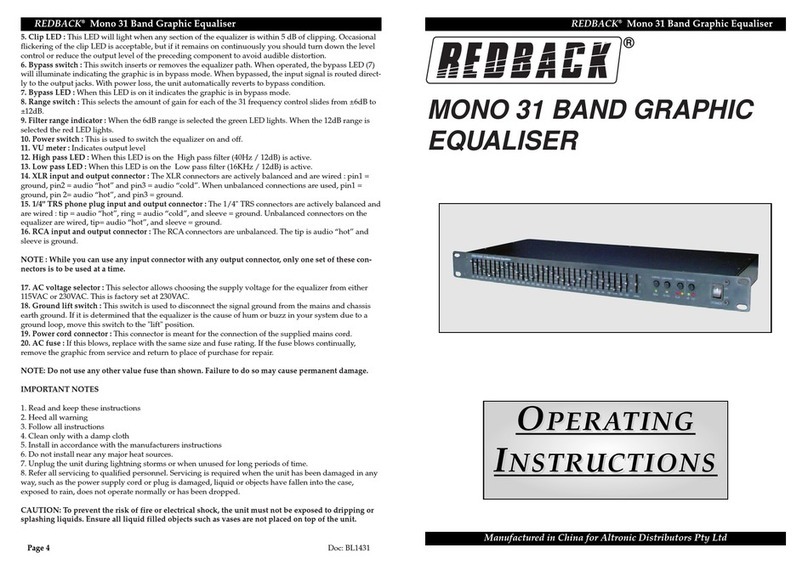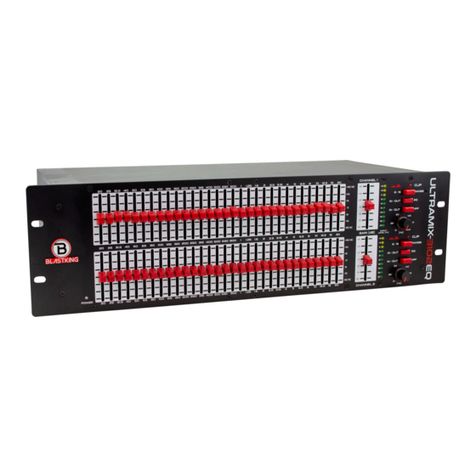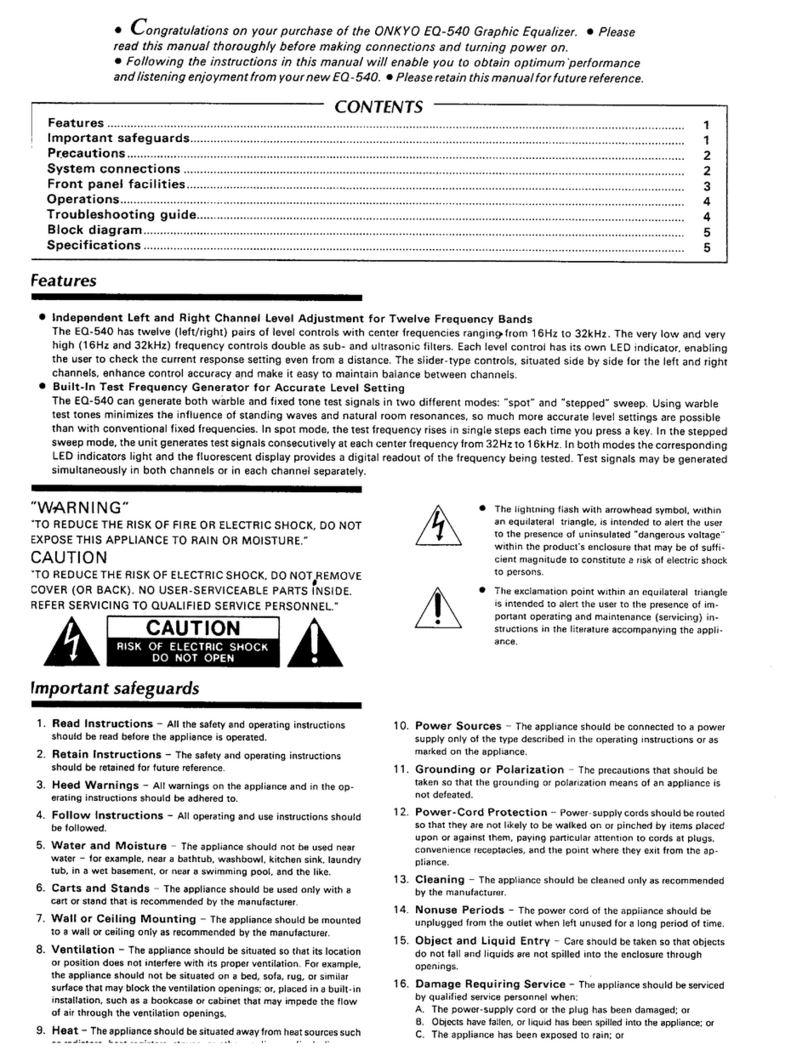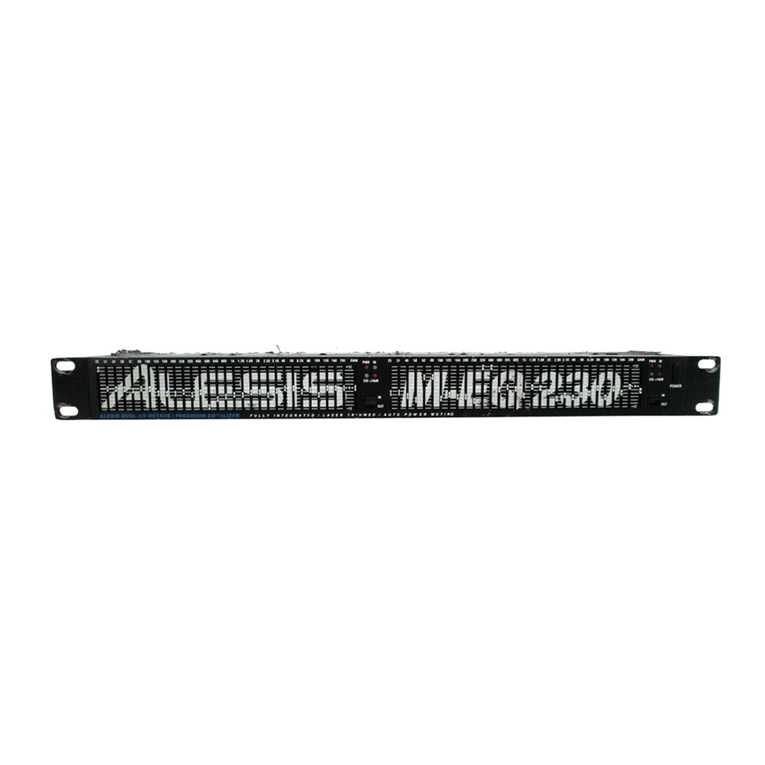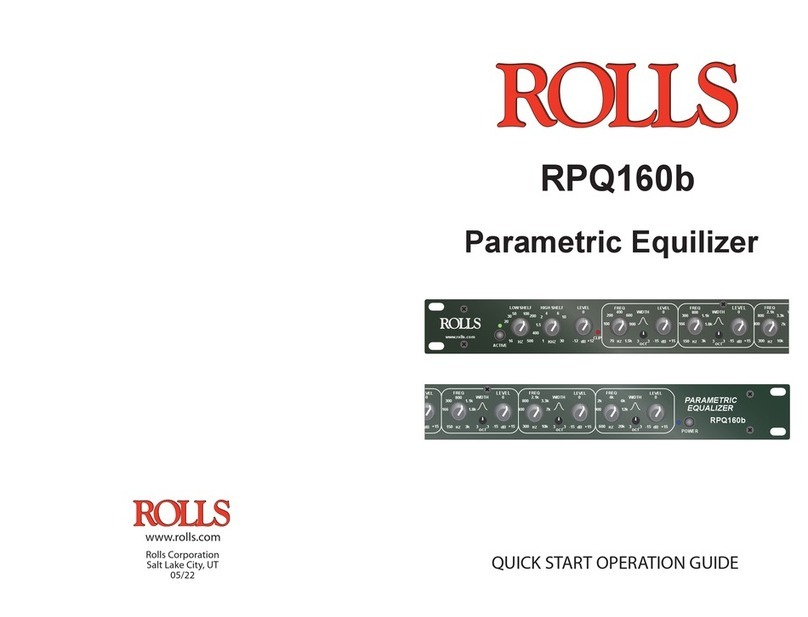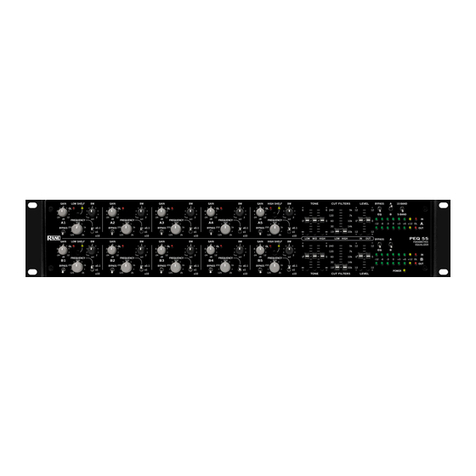Manley Enhanced Pultec Mid Frequency Equalizer User manual

MANLEY
LABORATORIES, INC.
OWNER'S MANUAL
ENHANCED
MID FREQUENCY
PULTEC EQUALIZER

CONTENTS
INTRODUCTION 3
EQ HINTS 4
FRONT PANEL 5
REAR PANEL 6
MAINS CONNECTIONS 7
TECH NOTES 8
TROUBLESHOOTING 9, 10
CURVES 11
WARRANTY 13
WARRANTY REGISTRATION 14
APPENDIX:
WIRING YOUR OWN CABLES ?
TEMPLATE FOR STORING SETTINGS
SECTION PAGE

INTRODUCTION
THANK YOU!...
for purchasing the Manley Laboratories Enhanced Pultec Mid Frequency Equalizer. The all-tube Mid
Equalizer utilizes the original WESTERN ELECTRIC passive-equalization circuit found in the long-out-of-
production and justifiably famous PULTECS. According to experts, Western Electric developed the passive
EQ in the 30's to improve speech quality in a typical telephone system. This may help to explain the choice
of curves and frequencies. Western Electric also seem to have brought us the balanced audio & the 600 ohm
standard. Eugene Shenk of Pulse Technologies re-discovered the EQ and added his vacuum tube gain make
upamplifier.WhilePultecsoldahealthynumberofunitstobroadcast,whentransistorscamein,manyjumped
to the new technology and Pultec fell on hard times. It was not until the mid 70's and early 80's with the big
newrecordingstudios,thatengineersandproducersfoundthatnothinghadthesamemagicthatoldPultectube
EQscouldgive.Twentyyearslater,andtheyarestillfavorites(alongwitholdBritishconsoleEQs)andtoday
few understand why they sound so good. Its not "just" the tubes.
We can offer a few good reasons. First - the EQ is passive. That means that the components involved have no
gain. A typical modern parametric EQ can use 10 to 20 op-amps, each with many, many transistors. Music
generally prefers a simple path with the fewest parts to pass a signal through. This also is one of the big
advantages to tube circuits - simplicity. The EQ uses a few capacitors, inductors and resistors (or pots). No
headroom problems, no crossover distortions, no slew induced distortions.
Second- Transformers can add a nice fat low end. That euphonic bottom was partially due to transformer
saturation.In otherwords thelower andlouder asignalgot,themore itsaturated (addedsome extraharmonics
totheultralowswheremostspeakersaredeficient).Ithelpsuspercievethat therewassomeenergydownthere
without hearing the distortion as such. The older transformers suffered from wide band distortion and losses
inthehighs.Thisisrarelywanted.Modernhighqualitytransformersaremuchbetterinthehighsandgenerally
much lower distortion, due to improvements in materials, but they can still saturate - the way we like.
Third - Op-amp circuits have limitations. They use negative feedback to control gain. Often enough, this can
cause a loss of transient accuracy and/or instability. Most op-amp EQ circuits rely on some very small signal
levels that are prone to cross-over distortions in the push-pull outputs. Older op-amps have slow PNP
transistorsthat began rollingoffat a fewhundredhertz causing crossoverdistortions. Headroom canbea hard
ceiling (+20 dBu) that gets nasty when significant amounts of boost are called for. All of this worsens when
driving capacitive wire or low impedances. The better solid state EQs are discrete with high voltage power
supplies for headroom. Our Langevin Pultec is that style. The Manley tube version beats it.
Manley uses an all-tube gain block with a +31 dBu capability and less than 10 dB of feedback. Four triodes
are used for "flat" class A gain stages and demonstrate the beauty of simplicity. We use a similar line amp in
our 40 dB Mic Preamps and Electro-Optical Limiters and some of our audiophile hi-fi preamps.
Our version of this classic EQ incorporates modern audiophile grade components with our proven line-amp
for absolute sonic beauty... Conductive plastic potentiometers and sealed gold-contact switches, polystyrene
and rolled film and foil capacitors, and a our own transformers combine with a regulated stiff power supply
and state-of-the-art tube circuitry to bring another classic PULTEC that is optimized for voice - but not only
voice.Theygetuseddailyinmasteringandseems tobetherighttoolforahugenumerofapplications.Beyond
the improvements in pure fidelity, we added extra frequencies and better interfacing, and it's only 1U !
Please take a few moments to read through this manual carefully as it contains information essential to proper
operation of this unit. Thank you again, and please enjoy!
3

EQ HINTS
We usually give a few hints about tricks commonly used with our products. With an
EQ of this type it is not so likely you need much help.
The most common question we get asked about our Pultecs is "Why not a boost/cut
knob in each band?". We don't know why it was designed that way for sure. It was designed
inthe1930'sbyWesternElectrictoimprovevoicethroughtelephonelines.Webelieveitwas
done this way because it was the most practical in a simple passive design. This was before
op-amps and Baxandall type cut / boost circuits were common. We do know how to design
& build that style but it wouldn't be a Pultec, it would need twice as many parts or not be
passive. Standard EQs are easy - Our customers requested Pultecs when they could have
anything except a new well built Pultec. David and EveAnna flew to New Jersey to request
permissionfromEugeneShenkofPulseTechnologiestousethecircuitsandname.MrShenk
was gracious enough to give it to them. Permission was also obtained from Western Electric
because they originated this passive EQ. We just improved it for a different era.
The obvious application is voice. Many acoustic and electric instruments benefit
from the choice of frequencies and bandwidths. We know it has been the magic touch on
harmonicas, acoustic guitars, and violins. Because almost all instruments have a reasonable
amount of mids, it can be handy very often. We suggest it in combination with another EQ
like the Manley Pultec EQP1-A which focuses on lows and highs. The frequencies
complement each other. This combination has proved powerful and flexible for mastering.
Many of the most recognised engineers suggest cutting rather than boosting.
Accordingtothem,itsoundslikelessphaseshiftandresonance.Theywouldstartbydipping
a little in the 150 to 1.5K area and not by boosting lows, then highs, then.... One obvious
advantage to this is maximised headroom. The Mid Dip section is great for this approach.
Another advanced technique of EQ is to approach it "in the mix" rather than "soloed'
andmore as anarrangement tool thanmaking every singlesound huge. Itis based onfinding
optimum areas in the spectrum of the mix to emphasize each sound. The denser the
arrangement, the more this may be needed. It is most difficult when the band participates in
the mix. Each player wants to hear thier instrument oversized, up-front and dramatic.
Producersand engineerswhocan hear,in their head,what themixshould bewith one ortwo
passesofthetapehavethemethod.TheMidEqhasproventobeagreattoolforthatapproach.
Theoppositeapproachiseverysoundisbig,andmostofthetracksaremuted.Howeverwhen
one gets great arrangements & great musicians playing together these "tricks" are not really
needed much. A hit song will probably be a hit regardless of your efforts or the mix but the
best memories is when it all clicked.
TheMidPultechasprettynarrowbandwidths,appropriateforfine-tuningor creating
some unusual character. Approach it like a fine tip paint brush. If what you need is a roller
brush,savetheMidEQforsomethingelselikethefinaltouch-ups.Tryitonpercussion,snare
or sax. These instruments often challenge the transient accuracy of solid state Eqs. They
might take on a smeared, edgy or pink noise quality. The better the monitor system the more
obvious this can be heard. Manley's circuits may sound quicker, cleaner & warmer.
4

IN
BYPASS 1
2
345678
9
10 1
2
345 6 78
9
10 1
2
345 6 78
9
10
200 300 500 700 1000 PEAK .7 1 1.5 2 3
.4 4
.3 .2 kHz 7 5
1.5 2 3 4 5 PEAKDIP
HIGH FREQUENCY kHzHz LOW FREQUENCY HANDCRAFTED IN CHINO, CALIFORNIA
MID - FREQUENCY EQUALIZER
A IN / BYPASS - Bypass, of course, disables the EQ function. The signal
always passes through the tubes.
B Hz LOW FREQUENCY - Determines frequency at which maximum low
frequency PEAK occurs. Choices are 200, 300, 500, 800 and 1 kHz.
C PEAK (LOW FREQUENCY) - Provides continuously variable BOOST from
0 to 11-12 dB to the selected low frequency. See the curves on page 11.
D MID FREQUENCY SELECT - Dermines frequency at which maximum DIP
in the mids occurs. 11 frequencies from 200 Hz to 7K. The 200 to 800
frequencies are great for clearing up some of the mud in sounds, 1 kHz to 4
khz to tame the nasal tones and painful hard sounds while the 5 or 7 kHz are
often used to compensate for microphone diaphragm resonances.
E MID FREQUENCY DIP - (peak) Provides continuously variable CUT from
0 to -10 or -12 dB to the selected mids. As with most LC passive EQs, as one
selects higher frequencies, the bandwidth narrows slightly and a little more
range of cut (or boost) is possible.
F HIGH FREQUENCY SELECT - Determines frequency at which maximum
high frequency PEAK occurs. Choices are: 1.5 kHz, 2, 3, 4, & 5 kHz.
G HIGH FREQUENCY PEAK - Provides continuously variable BOOST from
0 to 10 dB of the selected high frequency.
H LED POWER INDICATOR - When power is first turned on, the LED
should turn on RED. About 20 seconds later it will change to GREEN
indicating the signal can pass through. This is a power-on, power-off mute
circuit to prevent thumps and noises as the tubes are warming up (or cooling).
It is smart enough to ignore quick black-outs.
I POWER SWITCH - Powers the unit ON when switched UP. We suggest
turning the unit off when the session is over. The tubes will last longer.

REARPANEL
0º
180º
B
A
L
A
N
C
E
D
DIRECT
IN
CIRCUIT
GROUND
CHASSIS
BALANCED UNBALANCED
OUTPUT
A IEC MAINS SOCKET - Accepts standard 50/60 Hz AC mains voltage. Check that the
voltage indicated on the back is the same mains voltage as your country.
B FUSE HOLDER - To remove the fuse, push and turn the fuse holder cap. Use a 1 Amp
SLO-BLO fuse. Always replace fuse with same value and type.
C GROUND TERMINALS - Use these to minimise hum. See troubleshooting section.
Normally these two terminals are joined by a "ground" strap. Moving this strap is similar to
disconnecting the AC mains 3rd pin ground but includes the chassis/rack ground. You can
also connect a wire from the "circuit ground" to your console in some situations. Experiment.
D XLR BALANCED OUTPUT - This is a transformer balanced output which will drive any
impedance down to 600 ohms, but an impedance of 2000 ohms or greater is preferred. Pin
out is as follows: PIN1 = Ground, PIN2 = high (+), PIN3 = low (-).
E 1/4" UNBALANCED OUTPUT - The 1/4" output is a transformerless output and
disconnects the transformer & XLR output when a plug is inserted. Tip = Signal, Sleeve =
Ground, Ring = unused. Use either output but not both
F GAIN SET PRESET - This control adjusts the feedback over the line amplifier. It is preset
for unity gain, however, additional gain is available through this screwdriver adjust control.
G 1/4" UNBALANCED INPUT - 3000 ohm input impedance, unbalanced. It is meant as an
input that bypasses the transformer. This is too low as a "direct" for guitars but can be great
with an effects pedal or preamp between the guitar and EQ. You may need the gain these
pedals often provide. Most synths can drive this input but also may be low level.
H PHASE REVERSE - Switched in the UP position will retain the floating input signal in
phase. Switched in the DOWN position will reverse the phase of the floating input signal.
Switched in the MIDDLE position switches off the transformer and the high impedance
unbalanced 1/4" input is optimised. The 1/4" input is always on but not highest impedance
(3K) until the switch is in the middle position. The middle position kills the XLR in.
I XLR BALANCED INPUT - Fully floating / balanced input. Input impedance is 5000
ohms. Pin out is as follows: PIN1 = ground, PIN2 = positive going phase (+), PIN3 =
negative going phase (-). The PHASE switch must be on the "0" or "180" position.
A B C D E F G H I
6

MAINS CONNECTIONS
7
Your Pultec has been factory set to the correct mains voltage for your country. The
voltage setting is marked on the serial badge, located on the rear panel. Check that this
complies with your local supply.
Export units for certain markets have a moulded mains plug fitted to comply with local
requirements. If your unit does not have a plug fitted the coloured wires should be
connected to the appropriate plug terminals in accordance with the following code.
GREEN/YELLOW EARTH terminal
BLUE NEUTRAL terminal
BROWN LIVE terminal
As the colours of the wires in the mains lead may not correspond with the coloured
marking identifying the terminals in your plug proceed as follows;
The wire which is coloured GREEN/YELLOW must be connected to the terminal in the
plug which is marked by the letter E or by the safety earth symbol or coloured GREEN
or GREEN and YELLOW.
The wire which is coloured BLUE must be connected to the terminal in the plug which is
marked by the letter N or coloured BLACK.
The wire which is coloured BROWN must be connected to the terminal in the plug
which is marked by the letter L or coloured RED.
This unit (like most pro gear) is designed for third pin AC mains ground.
See the troubleshooting section if you usually use ground lift adapters (2 pin to 3
pin or "cheaters". You can use the ground posts on the back of this unit rather
than that method. Using these posts are safer and gets better results in most situa-
tions.
Ventilation. Two tubes only, so not bad. Worst - Small flight cases, packed &
insulated. Best - 1 space above and below. Good - 1 space above. Good - shallow
unit above, not blocking vent slots. OK - cool gear above and below, with air flow.
Power - Turn it off after the session. The tubes last longer.
Older units had a switch for 220/240 or 110/120 volt operation. While a nice
feature, it compromised the noise floor slightly. We now hardwire for each country we
send units to. So the few who move thier racks internationally have to use typical step-up
step-down transformers that they are probably using anyways. The vast majority who
don't fly gear globally have got quieter units. It is also a bit safer. We mark each unit on
the back panel for the voltage it is wired for - if in doubt, please check.

TECH NOTES
8
SWITCHING ON
The power switch is located on the right hand corner of the front panel. When one first turns on the power the LED
next to the switch is red, indicating "mute"- after about twenty seconds it turns green and audio can pass. This
prevents thumps or pops during warm-up and shut-down. The circuit is smart enough to ignore short black-outs. The
audio does not normally pass through the relay involved - the relay, when muted, simply shorts the output. Do not
switch on and off rapidly in succession as this is not good for the power supply. A recent update added high voltage
shunt regulators so that AC power variations were not reflected to the output. We also added output transformers.
TUBE LIFE
As with all tubes, their quality degrades with age. This is due to cathode emission, a natural process found in all
tubes. Excessive increase in noise (hiss) can indicate the need to replace a tube. Usually, the 5814/12AU7A will be
the one to try first as this is the tube in the gain stage. The 6414 is the output tube. Microphonics are a natural
occurrence found to some extent in all tubes. We try our best to select the least microphonic tubes possible.
TUBE SUBSTITUTION
This circuit has been optimised around the 5814 and the military 6414 tube types. We also believe these are the best
tubes for your unit. Replacement tubes can be obtained from Manley Laboratories. However, if you're stuck in a
pinch, the following tubes are approved substitutes for this unit:
For the 5814: 12AU7WA, ECC82 (exact substitutes)
For the 6414: 12AT7, ECC81, 12BH7A (not exact substitutes, but they will work fine with a little less current output)
CUSTOM VERSIONS
For mastering use, we also build a custom version of the Manley MID Frequency Pultec EQ which has
1/2dB switching BOOST and CUT controls replacing the continuously variable controls found in your unit. We also
build a Mastering Version of our Pultec EQP1-A.
SERVICING and TUBE REPLACEMENT
High voltages are present in this unit when powered and for 10 minutes after power is removed due to the slow
discharge of the high voltage capacitors. Before opening the top, remove the mains cable and let the unit "sit" for
about 10 minutes. Even then it is good practice to only use one hand in any high voltage gear and/or use rubber
gloves. Do not touch the circuit board or and resistors and capacitors as there may be some charge still remaining.
Wiggling the tubes slightly back and forth helps when removing or inserting them. Given these precautions, replacing
tubes is as easy as changing a light bulb. There is a metal tube shield over the 5814, Twist it slightly counter-
clockwise to remove it. It is used to reduce hum and light pick-up. Replace it after changing the tube.
6414
output tube
5814
input tube
EQ SECTION
POWER
TRANSFORMER
MIT Multicap
output capacitor
Gain make-up
amplifier

Thereareanumberofpossiblesymptomsofsomethingnotquiteright,somemaybeinterfacing,otherswewilltouch
on as well. On the back panel are balanced and unbalanced inputs and outputs. Usually we connect balanced outputs to
balanced inputs (same with unbalanced) but usually we can also patch an unbalanced to balanced or balanced to unbalanced
with no problem (especially true with transformers) but some gear you can't. Check the manuals if you find a problem.
NO POWER, NO INDICATORS, NADA - Probably something to do with AC power. Is it plugged in? Check the fuse on
the back panel. A blown fuse often looks blackened inside or the little wire inside looks broken. A very blackened fuse is a
big hint that a short occured. Try replacing the fuse with a good one of the same value and size. If it too blows then prepare
tosendthe unit back to thedealerorfactory for repair. The fuseisaprotection device and it shouldblowifthere is a problem.
If the unit works with a new fuse, fine. Check the MAINS VOLTAGE SELECTOR if one is fitted. Some of our models are
able to have them and some don't. It should be set correctly for your mains voltage.
LIGHTS BUT NO SOUND - First try plugging the in and out cables into some other piece of gear to verify that your wires
are OK. Assuming that it was OK into the other unit it probably is still a wiring thing. The XLRs are transformer balanced
(isolated / floating) that require the LOW or negative part of the signal on PIN 3 to be connected to something, even when
driving unbalanced inputs. With unbalanced sends or returns are used with the EQ balanced inputs/outputs then PIN 3 and
GROUND should be connected together. The EQ's unbalanced outputs kill the balanced XLR signals to provide a
transformerless audio path. Once again, when using a balanced to unbalanced (or vice versa) don't forget to have PIN 3
connected to the SLEEVE of the 1/4" plug.
LEVELS SEEM TO BE WRONG, NO BOTTOM - Several possible scenarios. Manley uses the professional standard of
+4 dBm = Zero VU = 1.23 volts AC RMS. A lot of semi-pro gear uses the hi-fi reference of -10 dBm = Zero VU. This is a
14dBdifferencethatwillcertainlylookgoofyandmaytendtodistort.Oftenthereareswitchesonthesemi-progeartochoose
the pro reference level. We do not provide that kind of switch because of inevitable compromises in the signal path. If the
loss looks close to 6 dB and it sounds thin then one half of the signal is lost. The cause is probably wiring again. One of the
two signal carrying wires (the third is ground / shield on pin 1) is not happening. Check the cables carefully because
occasionally a cable gets modified to work with a certain unit and it seems to work but its wrong in other situations. If you
have two and only one EQ exhibits this problem, it may be a problem in that unit. See the next item.
SIGNALGONEEVENINBYPASS- Thesignalgoesthroughthetubestagein"Bypass".Let'sassumethewiringhasbeen
checkedtwice.Thereisabouta98%chanceitisatube.Ifitweresolidstateyouwouldgenerallysenditbackforrepair.Being
atubeunit,youcanprobablyfindtheproblemandfixitinafewminutes.Nottoomanyyearsago,people(yourparents)could
"fix"theirown stuff by taking abagoftubesdowntothecorner and checking said tubesonatubetester.Thesearepractically
extinct but no prob'. Be careful - there are some high voltages inside the chassis and tubes can get pretty warm but if you can
replace a light bulb you should be able to cruise through this. Before you remove a tube, just take a look at them powered
up. They should glow a bit and they should be warm. If one is not, you have already found the problem. The tube's filament
(heater) is burnt out or broken (like a dead light bulb). The other big visual symptom is a tube that has turned milky white
-that indicates air hasgotten into thetubeor we joke"the vacuum leaked out".Either way replacethetube. They arenot hard
to find - even Radio Shack carries a fair tube stock and Manley can ship you a tested one. You can even pull a tube or two
fromaguitaramptoverify"itwasthatonenotglowing"butthengetanexactreplacement(substitutionlistonpreviouspage).
Before you pull a tube, pull the power out, let the unit sit and cool and discharge for 10 minutes, then swap, then power, then
check. Gentle with those tubes, don't bend the pins by trying to insert them not quite right. A little rocking of them as you
pull them out or put them in helps. When the problem follows the tube you found the problem - a bad tube. No soldering, no
meters, one screwdriver - easy. The good news is "easy" the bad news is "tubes have an very unpredictable lifespan.
HUM- Onceagain-severalpossibilities-severalcures.Mostlikelyitisaground loop. If you are using the 1/4" unbalanced
inputs,try thetransformer XLRs. Balanced inputs can reject humfrom ground loops, but it would be goodto break the loop.
The two most common procedures are: try a 3 pin to 2 pin AC adapter (about a dollar at the hardware store) which is better
than messing up the power cable by bending the ground pin until it breaks off. Method two - cutting the shield on one side
of the cable. This is usually done at every female XLR to "break" all loops. You may get a loop simply from the rack. All
the other gear in the rack is "dumping" ground noise onto the rack rails. Try removing the EQ from the rack so that it is not
touching any metal. You may have cured a non-loop hum. Some gear radiates a magnetic field and some gear (especially if
it has transformers) might receive that hum. A little distance was all it took. A cool method of reducing all sorts of hum and
noise is to use the new 60-0-60 balanced AC power transformers available from Equi=Tech and Furman. It costs more but
works best. Hum might be because of the unbalanced input but this hints at ground loops and questionable wiring.
TROUBLE-SHOOTING
9

IT MAKES NOISES WHEN THE FRONT PANEL IS TAPPED - An easy one. Some tubes become microphonic over
time. That means they start acting like a bad microphone. Vibration has caused the supports for the little parts in the tube to
loosen and now the tube is sensitive to vibration. Easy - Replace the tube. Which one? The one that makes the most noise
when you tap it (usually the 5814). It will have to be on , connected and speakers up but not too loud (save the speakers).
ITGOTHISSY-Also easy.Thisisagain acommontubesymptom. Youcouldswaptubes tofindtheculprit butaneducated
guess is OK too. Generally the first tube in the path is the one with the most gain and dealing with the softest signals. The
usual suspect is the tube that is usually located closest to the front panel volume pot or the 5814. You may find that you need
to choose the quietest tube out of several of that type. We do this at the factory.
DISTORTION - This might be a tube. Swapping is a good way to find out. It may be a wiring thing or mismatch as well.
Wiring problems usually accompany the distortion with a major loss of signal. Mismatches are a bit tougher. Without even
explaining the term "impedance" it is enough to say that a lot of gear is simply not capable of driving pro levels and low
impedances.Itwillsound like lost headroom, earlyclipping,distortionon peaks. Often changing the orderofprocessorswill
do the trick. Another not so rare place to look is the patchbay, your settings, the meter levels - it happens. This unit has high
input impedances, low ouput impedances and more headroom than most gear but will lose some of that headroom into 600
ohm inputs found in vintage gear. You can usually remove that 600 ohm (termination) and be better off.
DCORSOMETHINGATTHEOUTPUTTHATISINAUDIBLE-Thismighthappenanditmightbeaccompaniedwith
a strange hum or little whistles as it warms up. It only seems to occur with long cables. It happens on an older unit but not
on the newer one. Years ago we found a problem with our line driver section when it fed very long or cheap wire. The output
would tend to oscillate in the inaudible ultrasonic frequencies ( 200 kHz to 500 kHz) into high capacitance like a long cable.
We cured it by adding a simple 47 to 100 ohm resistor at the XLR. Newer units should not have a problem but if you have
an old one, we can FAX you a 25¢ fix. Real DC at the output would be such a rare find that we would be pretty surprised.
We use a $30 output cap to block DC. Most manufactures use a 30¢ electrolytic cap but we don't like the sound or reliability
of these. We also had some low level, low frequency output caused by AC mains fluxuations. We cured that with a unique
high voltage shunt regulator. Older units may can get this fitted if needed.
THEKNOBS "FEEL"LOOSE- This is a complaint that we get. We use Bourns conductive plastic pots. They are the best
sounding, most reliable pot that we know of. David showed us that they have less coloration than Penny & Giles faders on
bigconsoles.Unfortunatelythey"feel"loose.Wecouldusecheapunsealedpotslikemostothercompaniesbutthenwewould
not "feel"so good about puttingtheManley name onthepanel. The onlybettersolution we can offeris the detented Grayhill
11 position gold contact rotary switches that we use for the mastering versions. This will cost you. You may notice that we
are proud to share the name of the makers of the parts we use. A lot of research and listening goes into our choices. The name
on the front panel is also the name on the desk of the parts buyer.
WHATCANBEDONETOMAKEATUBE PROCESSOR LESSFRAGILE- There is astrangeandfalserumorabout
tubegear beingunreliableandfragile.They seemtoforgetabout allthoseoriginalPultecsand LA-2Asstillindaily operation
after30or40 years.Manyofthemhavebeenabusedbeyond belief. At least 95% of the ones made are infulldailyoperation.
What about all those old tube guitar amplifiers still working hard after the all the miles in the back of a truck. Tube mics,
like all condensor mics, are a bit fragile but it has usually been the mic capsule or cables and not the tubes. Now how much
solidstate gear fromthe 70's and80's still works(or is worthusing)? It wouldseem that 40year old tubegear is morereliable
than 20 year old solid state and more useful. On the other hand, we expect much of the the new cheap gear to have a short
life whether it uses tubes or solid state. "Fragility" is a question of "build quality" far more than the technology used.
The only tried and true way to increase the reliabilty factor in tube or solid state gear is to buy the well made stuff and then
carry back-up units like every touring company. If you can't have a "spare" unit at least have a few spare tubes. Do
manufacturers of solid state say "carry a few transistors or IC's or do they say "send the unit back with an approved RMA"?
We respect and use the some of the "old" techniques of manufacturing - using solid, thick metal chassis, hand
soldering,fewestpossibleconnectorsand"over-engineered"designs.Wealsogettousebetterpartsthanwereavailableback
then.Wecanuseconductiveplasticsealedpots,goldcontactjacksandswitches,hightemperaturecapacitorsandmorestable
1%toleranceparts.Wecanalsousesolidstatewhereitisbestused-inthepowersupply.Silicondiodeshavesomeadvantages
in some of our designs and we often use HexFets for regulators, with zeners.
We do all we can to make this unit not only reliable but also a unit you will enjoy for decades. We rarely get gear
back for repair and very, very rarely charge for anything except tubes. We used to give a "lifetime" free repair guarantee
(excepttubes)whichwasexpainedasyourlifetimeand/or the person you may have sold the gearto.Prettygutsybutitshows
how we feel the gear is gonna last. We officially modified our policy when more gear was becoming rentals and used live,
and almost industrially however we do believe in supporting our customers to every practical extent.
10


12
SPECIFICATIONS
Maximum Input (Bypass through Line Amplifier) +30 dBv
Maximum Output +30 dBv
Headroom (referenced to +4 dBv) 26 dB
Frequency Response: 10 Hz to 70 kHz +/- 0.5 dB
THD & Noise (1kHz @ +4 dBm) .015%
Noise Floor (Gain set to minimum) -80 dB Wideband
Signal to Noise 126 dB typical
Maximum Gain (via trim on back) 5 dB to -5 dB
Maximum EQ Boost 12 dB low mids, 10 dB high mids
Maximum EQ Cut 12 dB (10 db some freqs) (see curves)
Power Consumption .35 Amps @ 115 VAC
Fuse 1 Amp Slo-Blo
Size (2U) 19" x 1.75" x 10"
Actual Weight 10 Lbs
Shipping Weight 13 Lbs
Manley Enhanced Pultec Mid Frequency Equalizer

WARRANTY
AllManleyLaboratories equipment iscoveredbyalimitedwarrantyagainstdefectsinmaterials
andworkmanshipforaperiodof90daysfromdateofpurchasetotheoriginalpurchaseronly.A
furtheroptionallimited5yearwarrantyisavailabletotheoriginalpurchaseruponproper
registrationofownershipwithin30daysofdateoffirstpurchase.
Properregistrationismadebyfillingoutandreturningtothefactorythewarrantycardattachedto
thisgeneralwarrantystatement,alongwithacopyoftheoriginalsalesreceiptasproofofthe
originaldateofpurchase.Only1cardisissuedwitheachunit,andtheserialnumberisalready
recordedonit.
Ifthewarrantyregistrationcardhasalreadybeenremovedthenthisisnotanewunit,andis
thereforenotwarrantedbythefactory.Ifyoubelievethistobeanewunitthenpleasecontactthe
factorywiththedetailsofpurchase.
Thiswarrantyisprovidedbythedealerwheretheunitwaspurchased,andbyManleyLaboratories,
Inc. Underthetermsofthewarrantydefectivepartswillberepairedorreplacedwithoutcharge,
exceptingthecostoftubes.Nowarrantyisofferedontubes,unless:
1.aManleyLaboratoriespreamplifierisusedwithaManleyLaboratories amplifier,and
2.thewarrantyregistrationcardisfilledout.
Insuchacasea6monthwarrantyontubesisavailablewiththecorrectrecordingoftheserial
numberofthepreamplifieronyourwarrantyregistrationcard.
IfaManleyLaboratories productfailstomeettheabovewarranty,thenthepurchaser'ssole
remedyshallbetoreturntheproducttoManleyLaboratories,wherethedefectwillberepaired
withoutchargeforpartsandlabour.Theproductwillthenbereturnedviaprepaid,insuredfreight,
methodandcarriertobedeterminedsolelybyManleyLaboratories.Allreturnstothefactorymust
beintheoriginalpacking,(newpackingwillbesuppliedfornochargeifneeded),accompaniedby
awrittendescriptionofthedefect,andmustbeshippedtoManleyLaboratoriesviainsuredfreight
atthecustomer'sownexpense.Chargesforunauthorizedserviceandtransportationcostsarenot
reimbursableunderthiswarranty,andallwarrantees,expressorimplied,becomenullandvoid
wheretheproducthasbeendamagedbymisuse,accident,neglect,modification,tamperingor
unauthorizedalterationbyanyoneotherthanManleyLaboratories.
Thewarrantorassumesnoliabilityforpropertydamageoranyotherincidentalorconsequental
damagewhatsoeverwhichmayresultfromfailureofthisproduct.Anyandallwarranteesof
merchantabilityandfitnessimpliedbylawarelimitedtothedurationoftheexpressedwarranty.
AllwarranteesapplyonlytoManleyLaboratoriesproductspurchasedandusedintheUSA.
Somestatesdonotallowlimitationsonhowlonganimpliedwarrantylasts,sotheabove
limitationsmaynotapplytoyou.Somestatesdonotallowtheexclusionorlimitationofincidental
orconsequentialdamges,sotheaboveexclusionmaynotapplytoyou.
Thiswarrantygivesyouspecificlegalrightsandyoumayalsohaveotherrightswhichvaryfrom
state to state.

WARRANTYREGISTRATION
We ask that you please fill out this registration form and send the bottom half to:
Registration entitles you to product support, full warranty benefits, and notice of product
enhancements and upgrades. You MUST complete and return the following to validate your
warranty and registration. Thank you again for choosing Manley.
MODEL MANLEY MID FREQUENCY PULTEC EQ SERIAL No. ____________
PURCHASE DATE ______________ SUPPLIER ______________________
--------------------------------------------------------------------------------------------------------
PLEASE DETACH THIS PORTION AND SEND IT TO MANLEY LABORATORIES
MODEL MANLEY MID FREQUENCY PULTEC EQ SERIAL No. ____________
PURCHASE DATE ______________ SUPPLIER ____________________________
NAME OF STUDIO & OWNER _________________________________________
ADDRESS ___________________________________________________________
CITY,STATE,ZIP_____________________________________________________
TEL:________________FAX:__________________email:_____________________
COMMENTS?? We welcome your feedback!________________________________
_____________________________________________________________________

This manual suits for next models
1
Table of contents
Other Manley Stereo Equalizer manuals
Popular Stereo Equalizer manuals by other brands
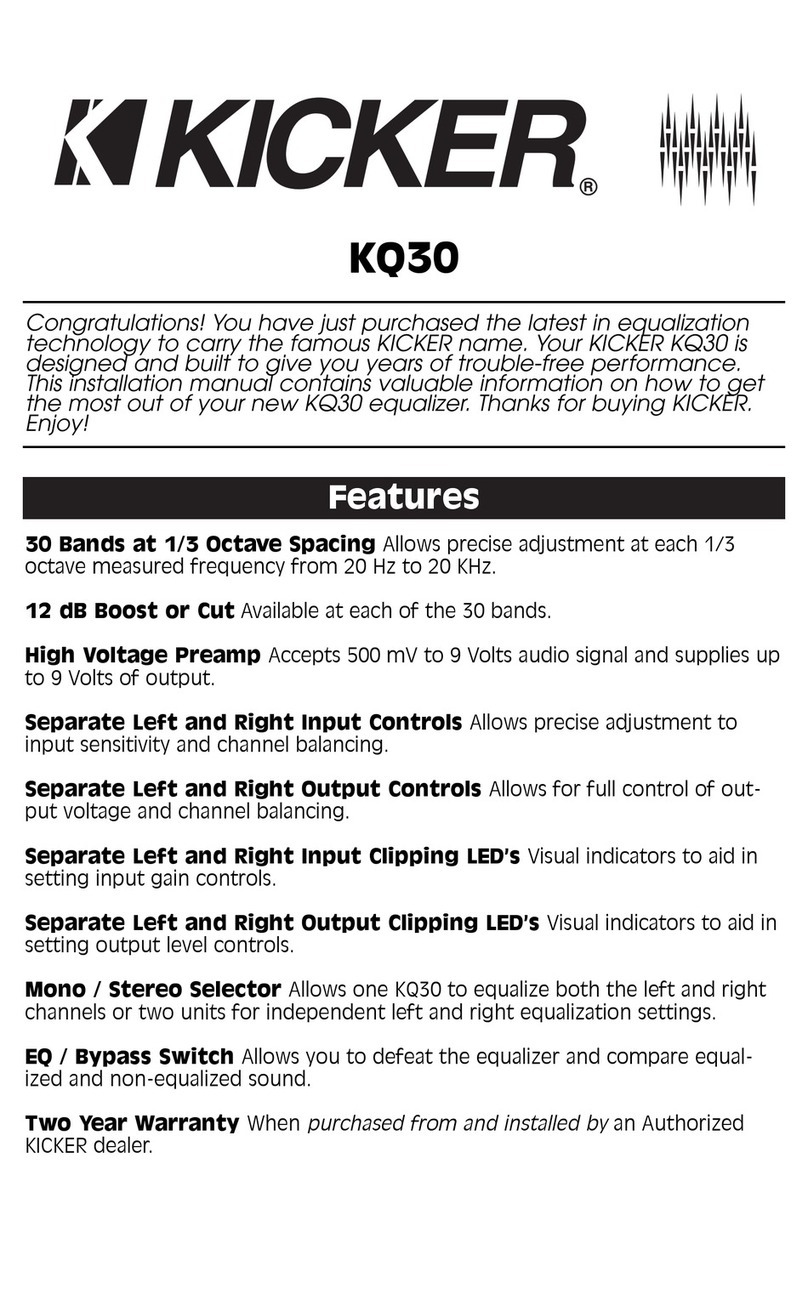
Kicker
Kicker KQ30 user manual
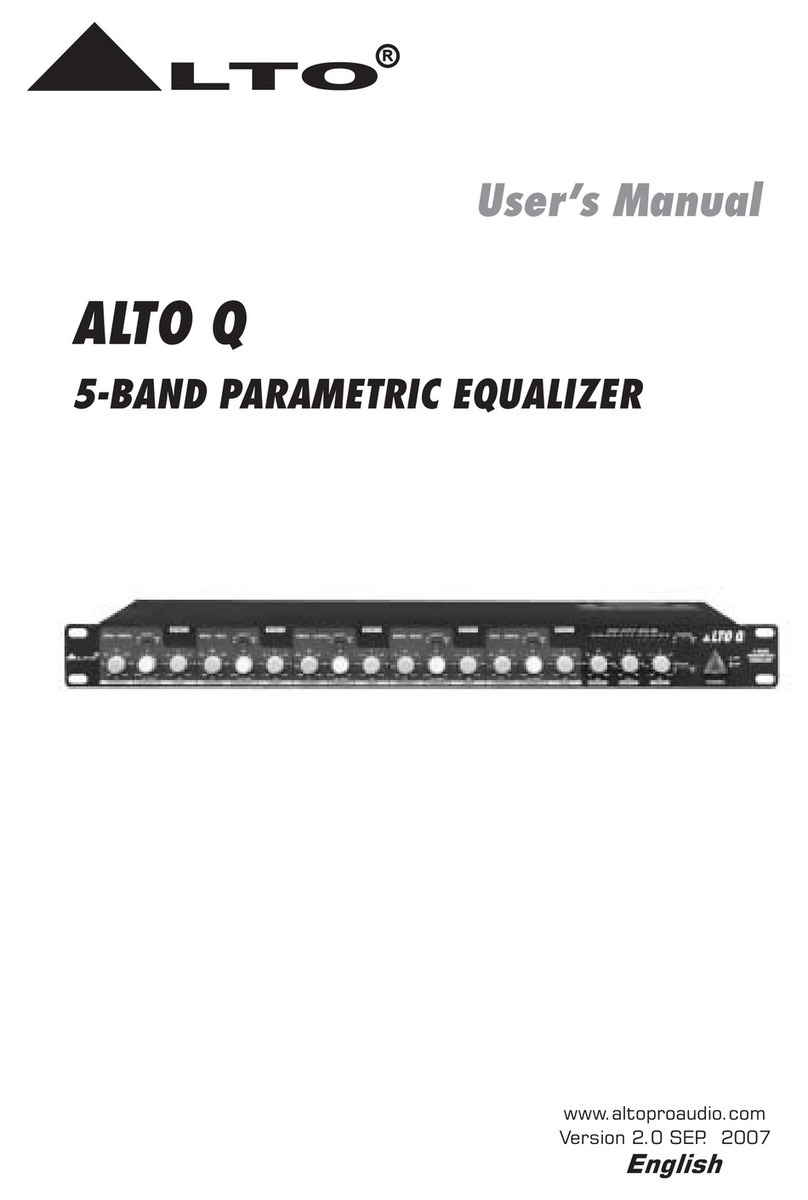
Alto
Alto ALTO Q user manual
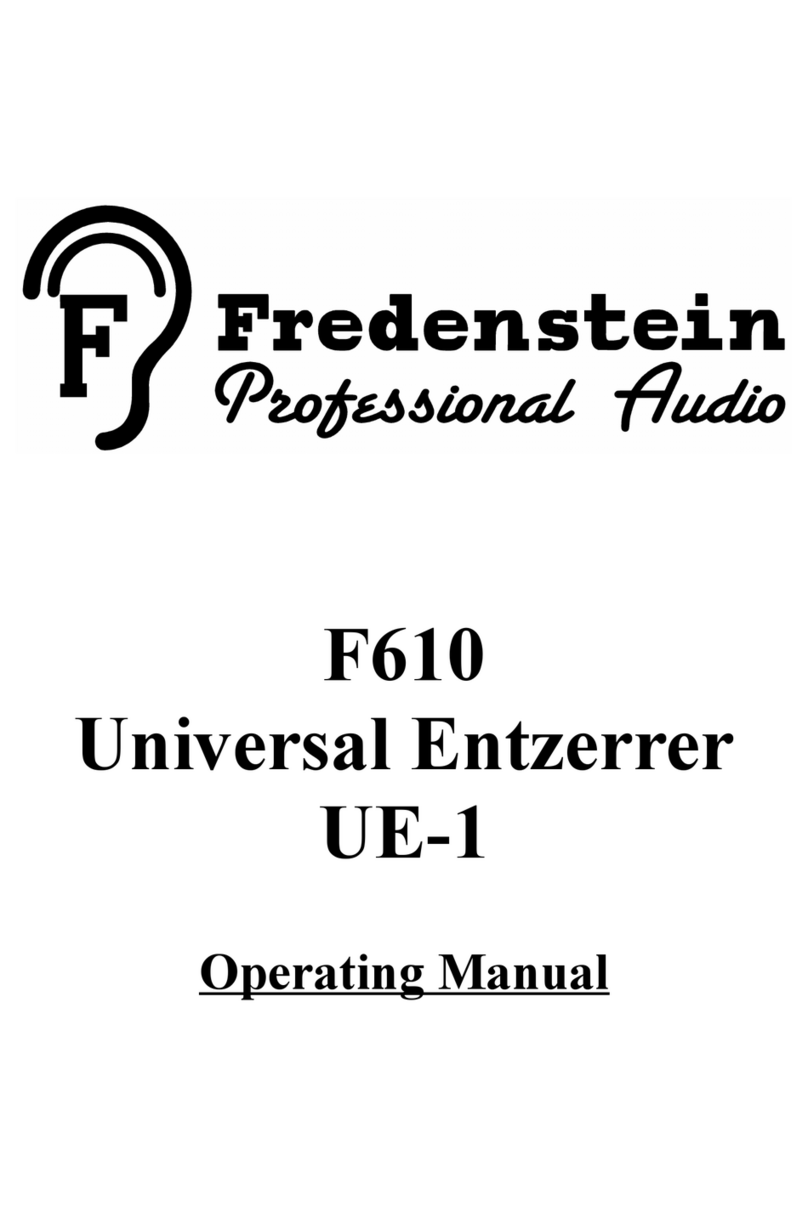
Fredenstein
Fredenstein F610 UE-1 operating manual
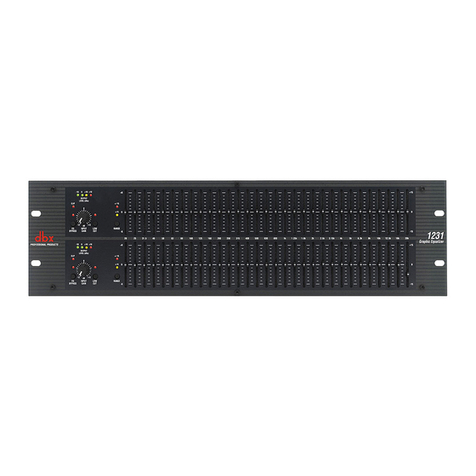
dbx
dbx 1231 Features & specifications
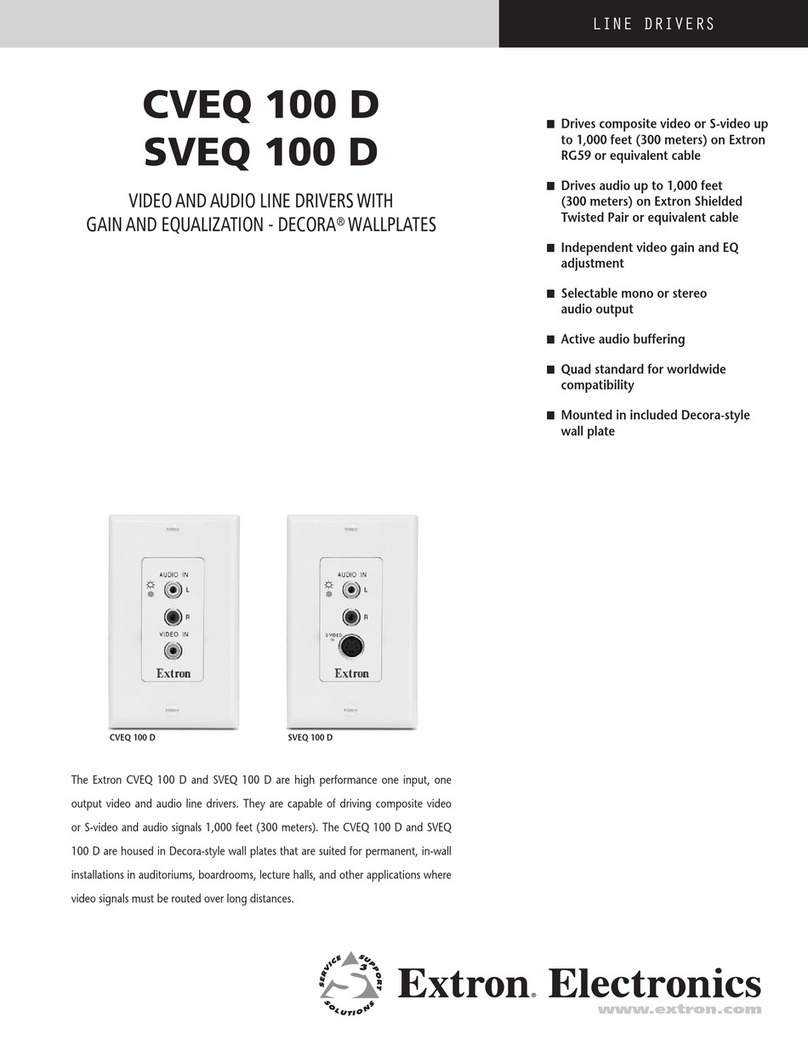
Extron electronics
Extron electronics Video and Audio Line Drivers with Gain and EquaLization CVEQ 100... Specifications
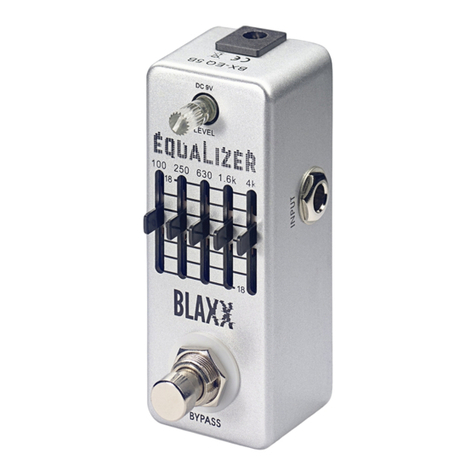
Stagg
Stagg BLAXX operating instructions


